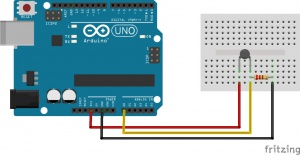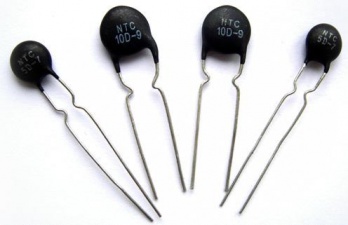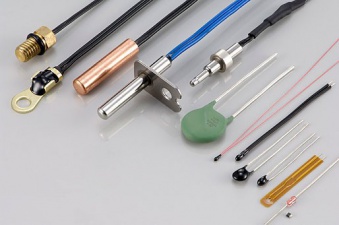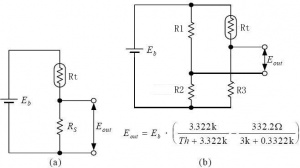Thermistor
- Thermistor (output ohm): NTC, PT100
Specification
Arduino
- Type: NTC 10D-9
- Resistor: 100ohm
#include <math.h> //include math.h
void setup(){
Serial.begin(9600); //baud rate 9600
}
void loop(){
double Digital_Value=analogRead(0); //analog read
double Voltage_Value=(Digital_Value/1023)*5.00;// voltage calculation
double Rt_Value=(3.3-Voltage_Value)/Voltage_Value*100; //caculate the resistor value of NTC
//caculate temperature and send
Serial.println( 1/(log(Rt_Value/10)/3000 1/( 25 273.15)) - 273.15,2);
delay(1000); //flash once per second
}
Introduction
- Thermistor resistance value changes with temperature semiconductor sensor, which is typically characterized by very sensitive to temperature resistance, at different temperatures exhibit different resistance values, thereby reversing the resistance value derived its performance in which ambient temperature. With high sensitivity, small size, low heat capacity, fast response and low cost advantages. According to the temperature coefficient can be divided into positive temperature coefficient thermistor (PTC), negative temperature coefficient thermistor (NTC) and the critical negative temperature coefficient thermistor (CTR). PTC with increasing temperature, the greater the resistance value exhibited; NTC as the temperature increases, the lower the resistance value exhibited; CTR having a negative resistance characteristic mutations, at a certain temperature, the resistance value sharply with increasing temperature reduced, with large negative temperature coefficient. Due to different characteristics, the use of the thermistor is different. PTC is generally used as a heating element and thermal protection; NTC generally used for temperature measurement and temperature compensation; CTR is generally used for applications such as temperature alarms. NTC temperature measurement range of -60 ~ + 300 ℃, nominal resistance generally between 1Ω to 100MΩ, using precision resistors and a thermistor to measure temperature combinations can be extended linear range. Figure 1 is a pictorial diagram of NTC, as shown in the figure NTC 10D-9 and NTC 5D-7. NTC thermistor is expressed as a negative temperature coefficient, 10D-9 and 5D-7 on behalf of its type, 10D-9 represents the normal temperature (25 degrees C) resistance of 10 ohms, a diameter of 9 mm, 5D-7 represent the normal temperature (25 ° C ) resistance of 5 ohms, the diameter of 7 mm. In addition to the shape shown in Figure 1, the probe has made the thermistor bead, stick the rod, sheet and film, etc., encapsulation shell cased glass structure, nickel and stainless steel tubes, etc., shown in Figure 2.
Caculation
There is a known non-linear relationship between the measured temperature and the NTC resistance value which exhibits, then measure the resistance value of the NTC temperature value can also be calculated in the measurement. Relationship between the resistance value of the NTC temperature values are as follows:
Rt = R x e^[B x (1/T1-1/T2)]
Where, Rt is thermistor resistance at temperature T1; R is the thermistor at room temperature T2 nominal resistance value; B value is an important parameter thermistor; T1 and T2 refers to the degree that is K Kelvin temperature, K degrees = 273.15 (absolute temperature) degrees Celsius.
Calculated inverse relationship between thermistor temperature and resistance value are as follows:
T1=1/(ln(Rt/R) /B 1/T2 )
Measure the resistance values are generally known to use a series resistor values and applying a voltage of known size, measured by dividing the value of the known resistance of the resistor, to calculate the measured resistance is obtained, as shown in Figure 3. Facilities plus excitation voltage Eb, the thermistor resistance is Rt, the series resistor is Rs, then dividing the value series resistor:
Eout = Eb x Rs/(Rt Rs)
In addition to the series measurement, there is a Wheatstone bridge measurement method, shown in Figure 4. Let bridge excitation voltage Eb, the thermistor resistance is Rt, the bridge resistor as R1, R2 and R3, the bridge output voltage is:
out = Eb x R3/(Rt R3) – Eb x R2/(R1 R2) = Eb x [R3/(Rt R3) – R2/(R1 R2)]





